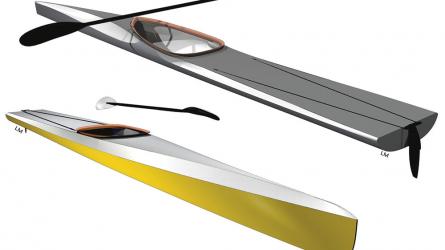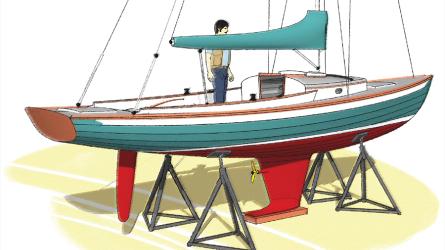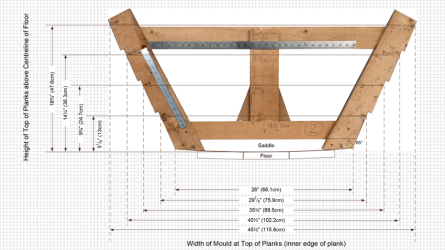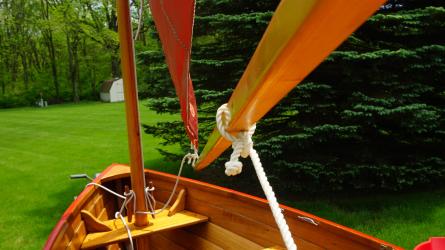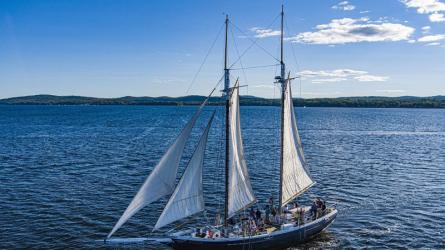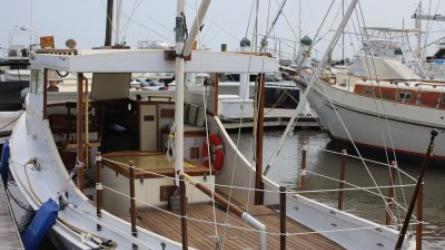MAUD Returns Home
Roald Amundsen’s last ship joins her peers
Roald Amundsen’s last ship joins her peers
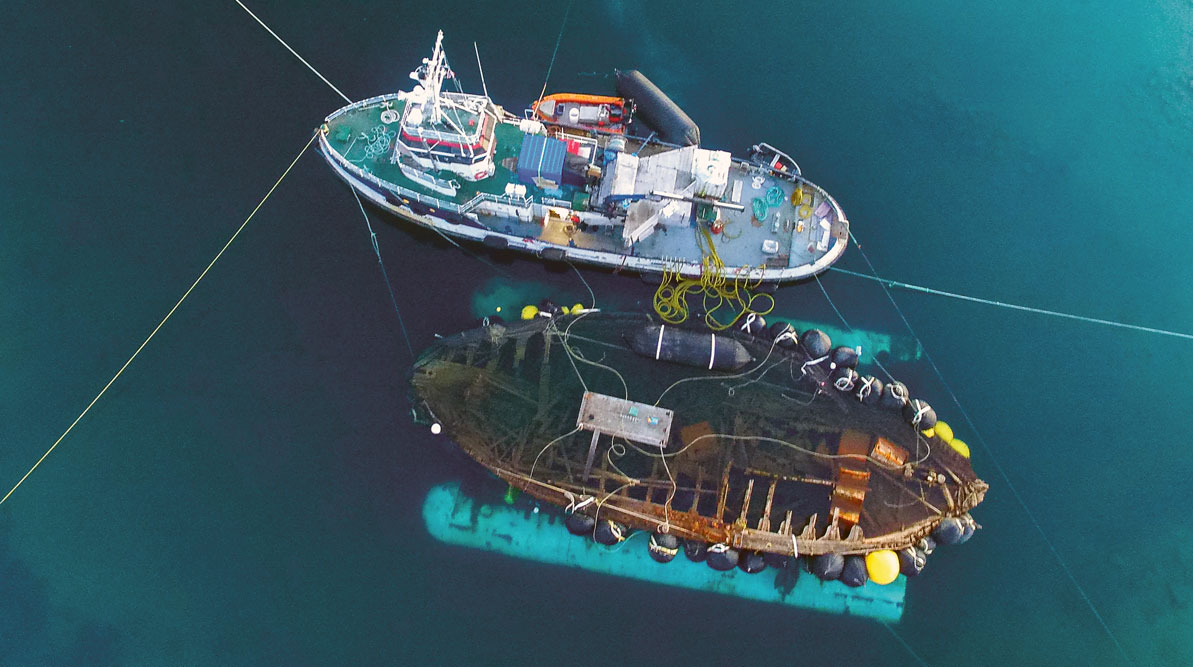
JAN WANGGAARD
Roald Amundsen’s Arctic exploration ship MAUD breaks the surface of Cambridge Bay, Nunavut, Canada, for the first time in more than 87 years, with the barge JENSEN lifting her hull and the tugboat TANDBERG POLAR by her side.
Toward the end of the Arctic spring in 1928, the Italian airship ITALIA, captained by pioneering aviator and polar explorer Umberto Nobile, crashed near Spitsbergen in the Barents Sea. Although Nobile wasn’t a particular favorite of the Norwegian explorer Roald Amundsen—they’d had a bitter and public feud after flying together on an earlier expedition—Amundsen, by then the world’s most renowned explorer, climbed into a Latham flying boat in Tromsø, Norway, on June 18 to join the search for the missing aviator. Ironically, Nobile was among those rescued, but Amundsen, whose plane crashed, was never heard from again.
It was Amundsen, however, who left the most astonishing legacy as a remarkable adventurer of the early 20th century—a legacy carried on today by the preservation of the three ships he used in his explorations of the North and South poles. FRAM, his Antarctic expedition ship of 1910–12 which had returned to Norway after that voyage, was saved for public exhibit in the 1930s. GJØA, in which he led the first transit of the Northwest Passage in 1903–06, joined FRAM there after being repatriated from San Francisco, California, in 1972. And finally, in 2018, the third ship, MAUD, which took Amundsen on his attempt to reach the North Pole, also returned to Norway. She had been raised from the bottom in Arctic Canada in 2016 and then towed home to the town of Vollen, where she had been specially built for Amundsen in 1917.
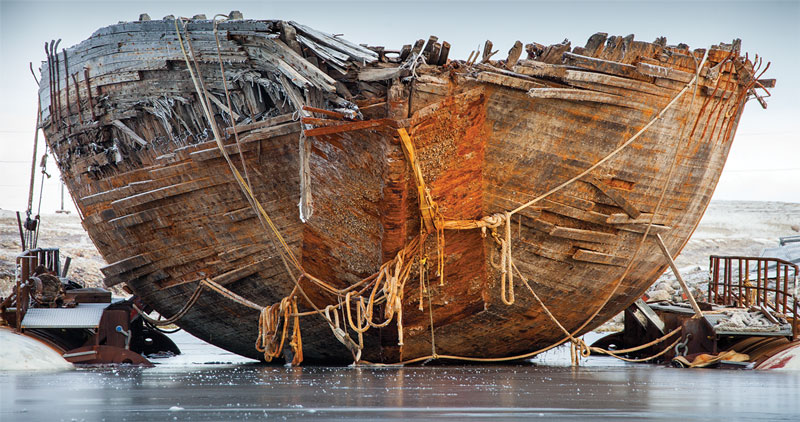
JAN WANGGAARD/MAUD RETURNS HOME
For a ship her age that has spent most of a century underwater, MAUD was in remarkably good shape due to the cold water and low salinity of Cambridge Bay. Even her ice sheathing—the rusty metal wrapped around the bow—was intact for the most part.
MAUD’s homecoming was cause for a national celebration in Norway. Tens of thousands of people turned out to greet the tow ship’s crew as they cruised southward toward Vollen, which is now a neighborhood of Asker, a suburb a scant 11.5 miles away by sea from Oslo. As MAUD approached, she was at last in well-protected coastal waters, and the only danger she faced on the last leg of her journey was being held up by the crowds.
At Vollen, MAUD has been housed under a temporary roof where she continues to dry. Eventually, she will be sheltered in a permanent museum building, like her peers. Since 1935, FRAM has been installed and exhibited in a purpose-built museum on Oslo’s Bygdøy peninsula. GJØA was exhibited outdoors at the FRAM Museum until 2013, when a building was built specifically for her; since then, she has been extensively restored. With the creation of the new MAUD Museum, all three of Amundsen’s ships of exploration will be preserved indoors.
MAUD had been largely forgotten since her loss in 1930. But 60 years later, interest in the ship began to take root. People in Cambridge Bay, Nunavut, where she sank, and also in Norway began to recognize her as a rare historic prize.
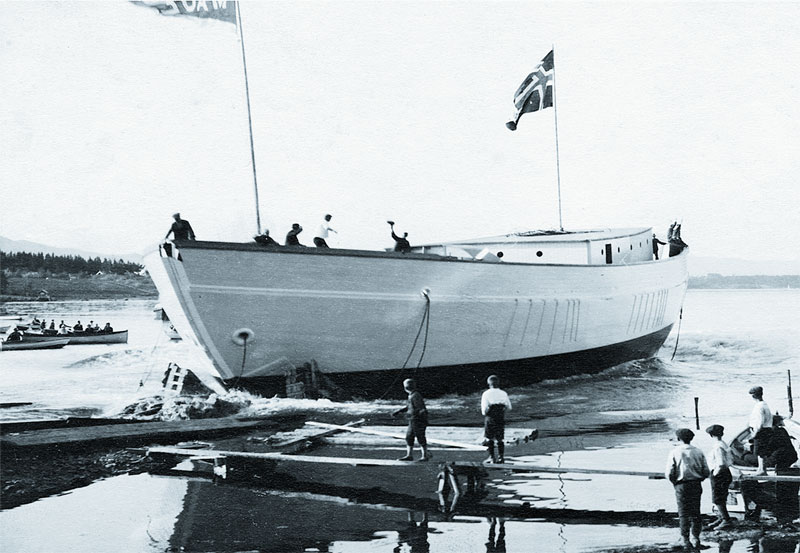
NATIONAL LIBRARY, OSLO, NORWAY
MAUD slid down the ways on June 7, 1917, in Asker, Norway, about 30 miles from Oslo and did not return for more than a century.
Amundsen’s ship had been purchased by the Hudson’s Bay Company (HBC) in 1925, renamed BAYMAUD, and repurposed as an Arctic supply ship. In 1990, the HBC sold her remains to the Asker Kommune, a Norwegian municipality, for $1. The Kommune intended to raise the ship and tow her back to her birthplace in Norway. A team from the maritime insurance company Det Norsk Veritas and the salvage firm AMCON was dispatched to survey the ship in October 1990. In 1991, the Canadian government had granted an export permit, but the idea never went anywhere because of its cost, estimated at $36 million Canadian (US$27 million at today’s rates). The permit languished.
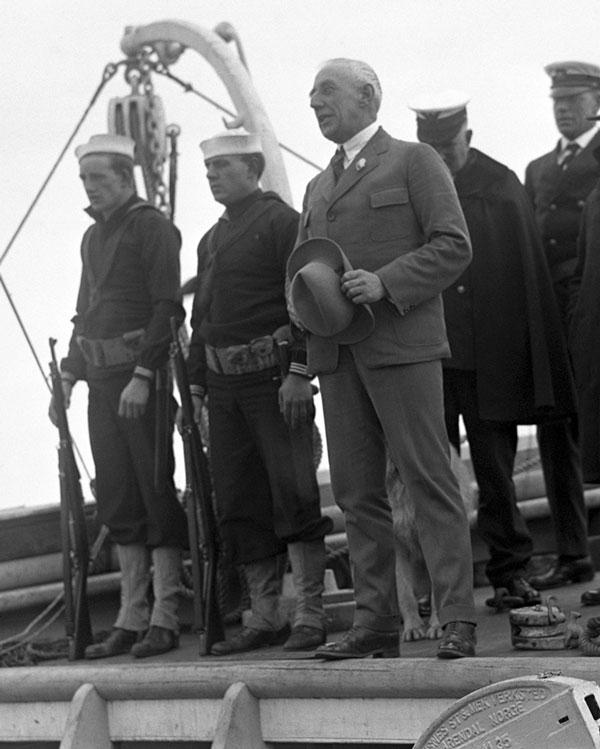
GLENBOW ARCHIVES (NC-1-764A)
Amundsen was a great promoter and never missed a chance to build his brand by making speeches to the crowds who gathered to greet the star of Arctic exploration.
Six years later, the government of the Northwest Territories asked marine archaeologist James Delgado, then the director of the Vancouver (British Columbia) Maritime Museum, to survey MAUD in detail. “She was in good shape,” he said. “There had been some flexing caused by the [winter] ice movement and a small crack opened along the garboard between it and the keel…. The keel was in very good shape.” He believes the ship probably sank by leaking around the propeller shaft, but there was nothing visible to explain the loss. Delgado even swam along the heeled-over ship’s entire length below the keel.
“MAUD was a perfect time capsule,” Delgado said. “I swam into the hold, and she contained a couple of bales of furs as well as one of Amundsen’s fireless cookers. The capstan on the deck was from FRAM,” which Amundsen had cannibalized quite a bit when fitting out MAUD. Deadeyes, blocks, and other detritus littered the beach.
The surveys concluded she might be salvageable, but questions remained about what would be the best approach: Leave her where she was? Haul her ashore? Haul pieces ashore and leave others as they were? Each point of view had its partisans.
Enter three Norwegian brothers with deep pockets: Gudbrand, Espen, and Franz Tandberg, highly successful businessmen based in Asker. Keenly aware of Norwegian history, they decided to do something that had never been done before. They wanted to raise MAUD and tow her home through the Northwest Passage to join GJØA and FRAM in Norway.
As it happens, Asker is also the home of the brothers’ company, Tandberg Eiendom AS, a commercial real estate development and management company. On June 7, 2011, MAUD changed hands once again, this time to MAUD Returns Home, an entity created and financed by Tandberg Eiendom.
For a project leader, the brothers turned to one of their employees, 53-year-old Norwegian dreamer Jan Wanggaard, who put together a crew consisting of Terje Mørkved, Stig Pettersen, Kjell Maryann, and Bjørn Myrann.
Raising MAUD hadn’t been a burning ambition for Wanggaard. In fact, he had barely heard of the ship, and what he knew of Amundsen was mostly background noise left over from his early school days. Nevertheless, the Tandberg brothers knew his track record of success on other difficult projects.
Wanggaard is also a longtime Asker resident, having moved there from Oslo when he was six years old. He was trained as an industrial designer in England before going to work with Tandberg Eiendom, but he had the imagination to bring projects to life.
Wanggaard and his crew headed for Cambridge Bay, on Victoria Island in Nunavut. They spent the month of August 2011 diving and making the engineering calculations for what would be required to gently raise the ship. As they worked, a number of Inuit elders approached Wanggaard politely and apologized for salvaging MAUD’s wood and metal many years earlier.
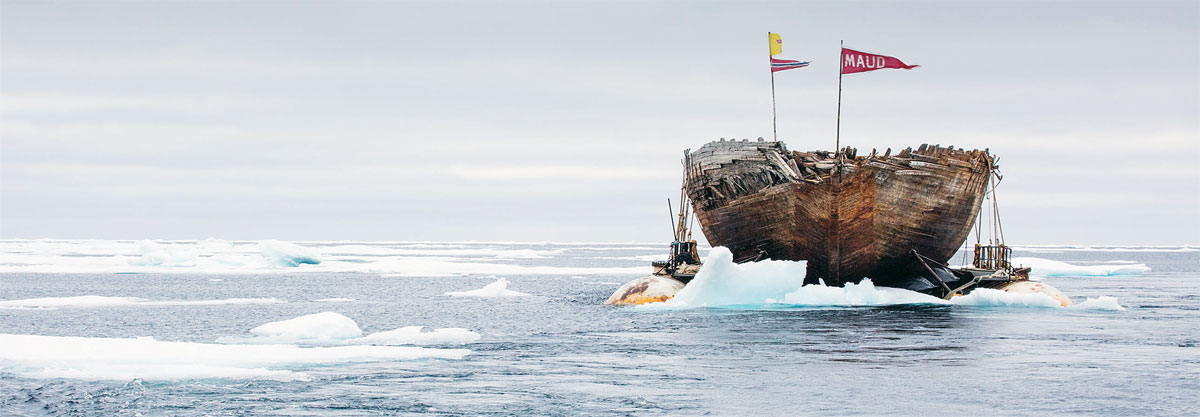
JAN WANGGAARD/MAUD RETURNS HOME
MAUD was towed through the Northwest Passage on the historic voyage home to Norway.
The team developed a plan. First, slings attached to airbags would be passed under the hull, with enough buoyancy to raise it off the bottom and suspend it just below the surface. Next, a submersible tow barge would be sunk and maneuvered into place underneath the suspended MAUD. Once ready, the barge’s chambers would be pumped dry so that it would rise underneath the ship, which would settle into a steel cradle and then be lifted out of the water.
However, on December 15, 2011, the Canadian government refused to issue a new export permit. Ottawa wanted another archaeological survey to determine whether the hulk could be safely raised and transported. MAUD Returns Home appealed, arguing that its proposal was the only viable one on the table. At a March 2012 hearing, a Canadian Border Services Agency review board relented and ordered the agency to grant the permit. Wanggaard and his crew were back in Cambridge Bay the following August. With only two months of ice-free water at best, preparations for the lift would take two summers.
As things developed, so did Wanggaard’s attachment to the ship and her explorers. “I have personally fallen in love with MAUD,” he wrote in July 2013, “and all those endless events of glory, but also great tragedy, that are woven into the story.”
More than a hundred years earlier, Amundsen became the superstar of polar exploration when he conquered the Northwest Passage with GJØA, a reinforced herring sloop. After that triumph in 1906, he turned around and drove his ice-ship FRAM south to the Weddell Sea in Antarctica, and from there he raced overland on skis to become the first person to reach the South Pole.
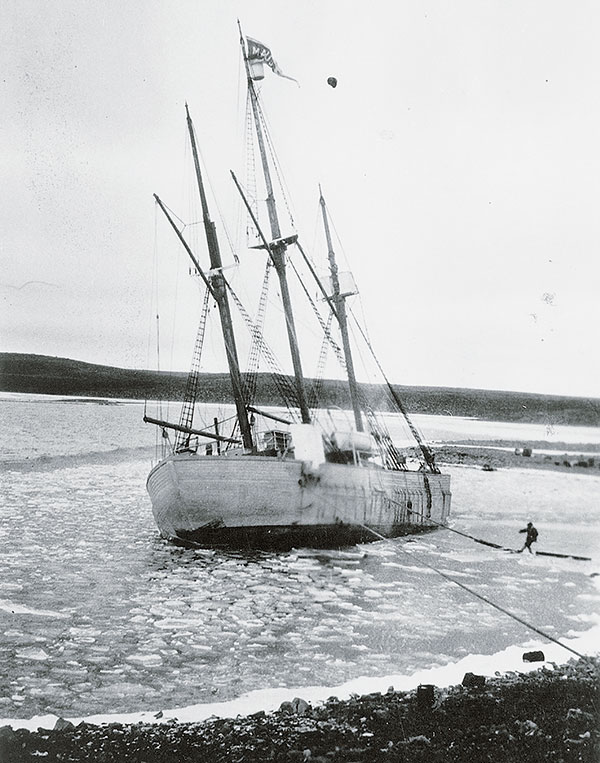
VANCOUVER MARITIME MUSEUM ARCHIVES (HNOS-30-12)
Before the end of the short Arctic summer in 1930, MAUD, by then renamed BAYMAUD by the Hudson’s Bay Company, began to settle in Cambridge Bay. The sinking was attributed to leaks around the propeller shaft. Before the ice finally closed in she had settled to the bottom, but with her bulwarks still exposed.
Colin Archer, a Norwegian designer of Scottish ancestry, designed FRAM for polar explorer Dr. Fridtjof Nansen, who had recognized the need for a specialized vessel. Archer had her sheathed in greenheart, the South American evergreen so tough it is nearly impossible to cut with hand tools. He also ran cross-bracing to help withstand the lateral and longitudinal pressures of ice, and he recognized the wisdom of Nansen’s request for a rounded hull that would let the ice lift the ship rather than crush it.
Starting in 1892, FRAM completed successful Arctic expeditions under Nansen, Otto Sverdrup, and Oscar Wisting. Amundsen acquired her after she returned to Norway with Wisting, and he commented that “…though she was a good deal worse for age and wear, I felt she was still capable of standing the pounding of the polar ice and would carry an expedition safely.” FRAM carried Amundsen in his successful attempt on the South Pole in 1911—but the voyage was not the one the explorer sold to his government.
In November 1908, Amundsen announced to the world he would try once again for the North Pole, and in February 1909 he received funding to refit FRAM. His plan was to round Cape Horn and then enter Arctic waters via the Bering Strait between Alaska and Siberia, heading for the North Pole. A month later, Ernest Shackleton came within a hair of the South Pole before abandoning his attempt in ENDURANCE. This opened a window of opportunity for a new and impressive record.
With American explorer Robert Peary already closing in on the North Pole, Amundsen may have feared he would become an “also-ran.” The mercurial Norwegian played his cards close to the vest, continuing to pretend his objective was the North Pole via the Bering Strait. When FRAM was midway down the Atlantic, he announced to his crew they were actually heading to the South Pole before another British expedition, led by the doomed Robert Falcon Scott, could make its attempt. FRAM carried the Norwegians successfully into the Weddell Sea, allowing them to mount their overland trek to successfully claim the pole.
When the ship and her crew returned to Oslo, Amundsen was hailed as a hero of classic proportions; his deception was forgiven. But Amundsen brought back two things beyond his name on the cairn at the pole: He now carried a thorough understanding of what an Arctic exploration ship should be and had the prestige necessary to find the funding for what offered to be his most ambitious project yet.
He commissioned a new ship, MAUD, named after Norway’s queen. The ship was based on Archer’s design for FRAM, but with modifications. He instructed Christian Jensen’s shipyard in Vollen to make the shape of the hull to be even more of a flowing, curvilinear design: “…the vessel’s bottom would be rounded at every point, so that, when she should be caught in the grinding ice, there would be no surface on which the ice could take hold, while on the contrary the ice pressure would tend only to lift her to the surface.”
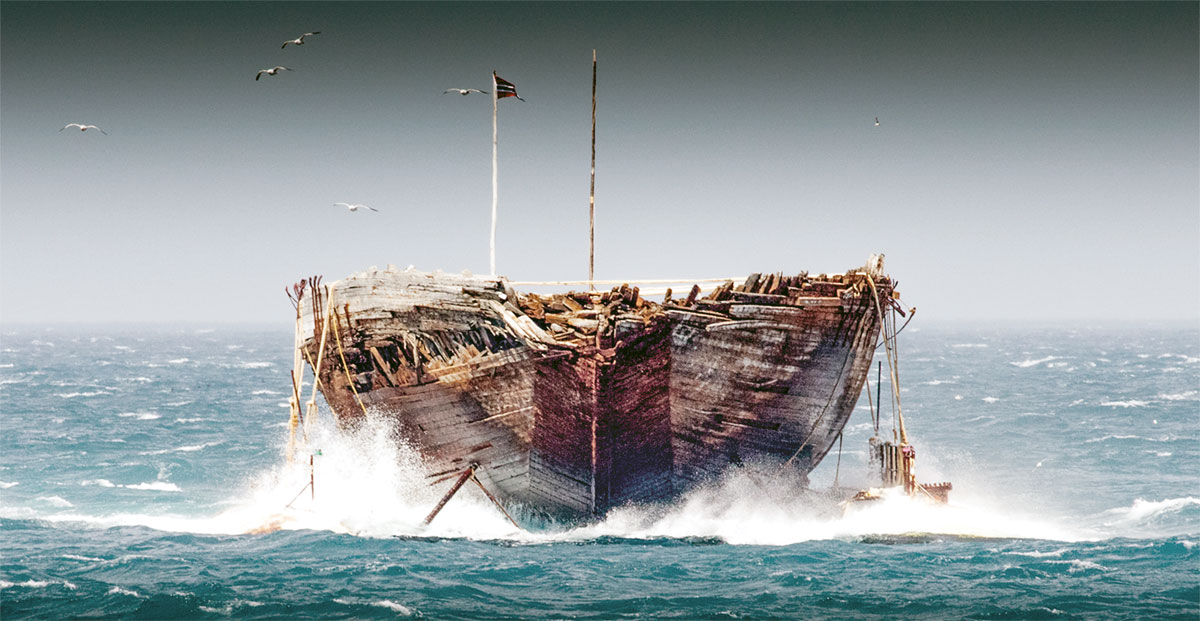
JAN WANGGAARD/MAUD RETURNS HOME
North Atlantic gales such as this one, encountered east of Iceland, tested the mettle of MAUD and her consorts. The conditions were handled safely by lengthening the tow lines between TANDBERG POLAR and the barge JENSEN so that the cable would create a swooping catenary, which acted as a spring to absorb shock loads.
With men expected to live aboard for extended periods in the harshest environment on the planet, Amundsen made sure MAUD would be a comfortable home. There was steam heating throughout, comfortable bunks, hot water and bathing facilities, drying lockers for outdoor clothing, and a library and game room where the crew could relax. While christening MAUD on June 17, 1917, by smashing a block of ice on her bow, Amundsen told the ship, “You are made for the ice. You shall spend your best years in the ice, and you shall do your work in the ice.”
Amundsen sailed that month for the Northeast Passage, north of Russia. It took two winters to get to Alaska from Norway. When he reached Nome in 1920, Amundsen chalked up another “first” to his list by crossing GJØA’s earlier westbound track, thus becoming the first person to circumnavigate the globe entirely in Arctic waters. After a brief respite in Nome, he set off again. Near Cape Serdze Kamen in Siberia, MAUD froze in for a third winter.
When the expedition broke free of the ice in the summer of 1921, the ship’s propeller had been damaged and she needed other repairs, so MAUD turned south to Seattle, Washington, for a winter refit. The next spring, she sailed north again, but without Amundsen. He had distanced himself from the expedition by making marathon dogsled and ski trips across Alaska, and he was also becoming enthralled with air exploration. He had attempted a transpolar flight from Wainwright, Alaska, while MAUD drifted with the ice pack.
When Amundsen caught up with MAUD in Nome in 1922, in a characteristic display of “cost-be-damned” bravura, he arrived with two airplanes, having decided aviation was now the future of Arctic exploration. One of the aircraft was an open-cockpit, two-seat Curtiss Oriole biplane used for short reconnaissance flights. The other was larger, a Junkers JL-6 that carried nine in an enclosed cabin. This was the airplane in which Amundsen attempted his first transpolar flight, which was unsuccessful. Regardless, Amundsen became the first aviation pioneer to use a ship as a base and the first to take off in the polar region.
He had burned through his own fortune by the 1922 season, and the MAUD attempt to drift over the pole continued for several years more, through 1924. Amundsen was sailing close to the wind on his expenses. His global reputation was no protection from creditors. Now, he had two expeditions—the ice drift and the transpolar flight—with, as the Amundsen biographer Stephen Brown put it, “…funding for only one.” Creditors began dunning Amundsen through his bank in Nome. He sold property in Norway to satisfy some, but not all, of his debts as the expedition continued.
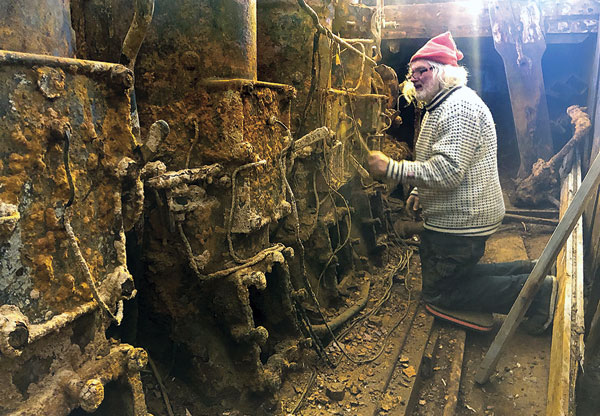
JAN WANGGAARD/MAUD RETURNS HOME
Bjørn Myrann begins the arduous job of cleaning the four-cylinder, two-stroke Bolander diesel engine. It’s not expected to run, but once cleaned will be kept in place in the engineroom as part of the permanent display.
When MAUD returned to Seattle for another refit in 1925, the creditors closed in and seized MAUD for the $8,784.48 in liens filed against her. It was in December of that year that the HBC, always looking for a deal, purchased her for $40,000. The ship, renamed BAYMAUD, drew too much water to be useful. She ended up anchored in a small cove adjoining Cambridge Bay, some 2,000 miles from Nome, as a floating warehouse and machine shop. She also became a floating radio studio, and the first radio broadcasts from the Arctic, which mainly consisted of weather reports, were transmitted from her wireless room by the fledgling Canadian radio service which later became the Canadian Broadcasting Corporation.
Over time, she started taking on water. Throughout late August and early September 1930, BAYMAUD gently settled to the bottom. Delgado and Wanggaard both believe the ship’s loss was due to leaking around the propeller shaft, even though rumors still abound that the HBC allowed her to sink, or may have even ordered her scuttled to save money. She went down by the head and rolled onto her port side, with her starboard bulwarks remaining visible above the surface.
In the winter, locals cannibalized her wood and iron, both of which are rare commodities above the Arctic Circle. The deckhouse’s wood was stripped for building materials. Local reports had the foremast erected in the tiny hamlet as a flagpole.
In 1947, Henry Larsen, the Royal Canadian Mounted Police (RCMP) commander of the ship ST. ROCH (see sidebar below), recorded seeing the HBC flag still flying from the hulk. Larsen didn’t pay much more attention, since he was busy dynamiting BAYMAUD’s stern to remove leaking fuel tanks that had been poisoning the local fishery.
And there she remained, until breaking the surface once more in 2016.
Over the winter of 2013–14, MAUD Returns Home had purchased a tow tug, rechristened TANDBERG POLAR, and built the submersible barge, suitably named JENSEN after Christian Jensen, MAUD’s builder in Vollen. In late June 2014, TANDBERG POLAR and JENSEN set off to the west across the North Atlantic from Norway. Wanggaard’s century-spanning relationship with Amundsen was maturing, as became clearer with each log entry—some of which he addressed with the salutation “Dear Roald.”
The vessels arrived in Cambridge Bay on September 11, 2014—too late to do the lift and return through the passage before pack ice moved in. Temperatures were already below freezing. Now, 2015 became the designated departure year. Ann and Glenn Bainbridge, a British couple sailing through the passage on their own yacht, a 40′ aluminum-hulled sloop named GJØA, served as shipkeepers for TANDBERG POLAR through the coldest winter weather; meanwhile, the team returned to Norway to make detailed preparations for the next season.
Diving started in earnest in July 2015. The ice was late in leaving the bay, and it wasn’t until September that Wanggaard could attempt the lift. This meant that another winter would pass before they could chance the passage.
The calculations involved in raising MAUD required a lot of guesswork. Because she was built primarily of wood, the difference in weight between the submerged and floating wreck would be substantial. Wanggaard estimated the buoyancy difference between fresh oak and the ship’s waterlogged timbers could be as much as 90 percent. MAUD’s construction also used a substantial amount of iron—from the 13-ton engine to the knees, from the fastenings to the metal stemband. There was also an unknown amount of movable ballast. “We really don’t know for sure the total weights…so all we can do is estimate from what we have read and heard,” Wanggaard said.
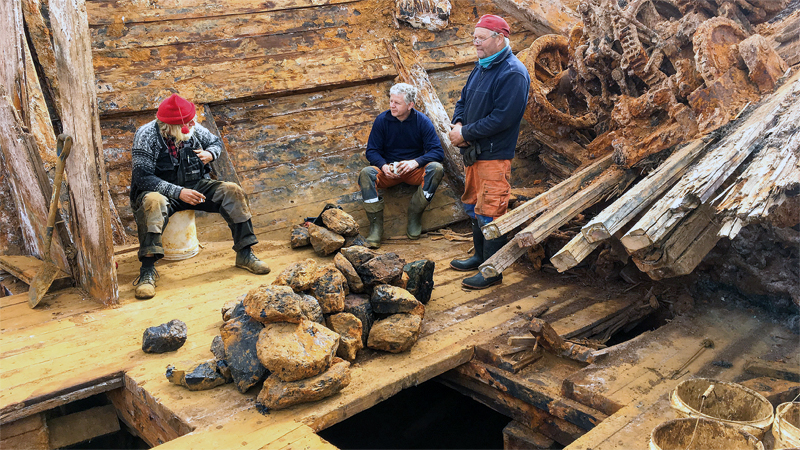
JAN WANGGAARD/MAUD RETURNS HOME
The crew—left to right, Bjørn Myrann, Stig Pettersen, and Terje Mørkved—take a break to contemplate the movable ballast found in the hull. The boulders caused problems in calculating the lift necessary to raise the ship because they were not inventoried anywhere.
In the end, he designed lift airbags for the maximum estimated buoyancy and crossed his fingers. Forty of these airbags, providing a total of 160 tons of lift, were deployed around the wreck, connected by slings made of Spectra cordage.
The first lift attempt came in the summer of 2015. Initially, the airbags took off for the surface with minds of their own, and they had to be brought under control before they twisted the ship. The solution was to cut them in half so that they were open-bottomed parachute bags that bled excess air. The method worked. With the adjustments, MAUD’s port side came up, and she remained level.
But it was the next year, on August 1, 2016, while diving on MAUD’s stern to top-up an airbag, that Wanggaard noticed a sudden increase in the water’s turbidity. Rising to the surface, he saw Stig Pettersen’s grinning face and realized that the bottom mud had released its grip on MAUD’s keel, and she was now floating free.
“I swam all the way down to the rudder,” Wanggaard wrote that night, “and let my hand feel under it. Yes. There was plenty of water under her. I saw a wonderful line of light all along the keel forward.”
As a postscript to the day, he wrote, “Dear Roald Amundsen—The story of MAUD and her destiny has not come to an end. Nearly 100 years after you baptized her in Vollen, she will sail home again and I welcome you to come along. It’s time to rest.”
Once raised, MAUD could at last finish her Arctic voyage by returning to Norway, as Amundsen intended. But she would be a century later than expected.
By mid-September 2016, MAUD was suspended, still submerged, in her slings. TANDBERG POLAR towed her into deep water, where the submersible barge was successfully slipped under her; the barge then slowly raised her to the surface, exactly as planned.
MAUD needed to spend one more winter in Cambridge Bay, because by mid-September ice blocked the passage out. For Wanggaard, this wasn’t traumatic, because experts advised him to let the ship shed its absorbed water in the dry Arctic air before attempting the ocean crossing. Tons of mud and debris also had to be shoveled out and sorted through to get the ship ready for travel.
At the end of August 2017, everything was set. JENSEN, with MAUD aboard, was towed out of Cambridge Bay on the first leg of a voyage that would take her eastward through the Northwest Passage. Once out of Cambridge Bay, the ships crossed Queen Maud Gulf. Ice plugged Victoria Strait almost to the entrance of Bellot Strait, so the voyage made an end-run south of King William Island and up its east side to James Ross Strait. Transiting the tight narrows of the Bellot Strait requires expertise and patience, because the confining walls increase the velocity of the normally meek Arctic tidal currents. Once through at slack tide, they continued north on Prince Regent Inlet to Lancaster Sound.
This segment of the journey was slowed again by changing ice conditions. The crew had to monitor ice reports from the Canadian Coast Guard continuously to avoid becoming trapped. Sometimes they acted as their own icebreaker, and two private yachts followed them through the leads they created.
Lancaster Sound is the eastern end of the Northwest Passage and beyond that lies Davis Strait—the last big hurdle of the 2017 season. It wasn’t going to be easy. Following the coast of Baffin Island southward until the convoy could turn across the Davis Strait to head for Disko Island on the Greenland shore, they almost dodged the weather, but in the strait the winds kicked up to near gale force.
Wanggaard was worried about how JENSEN, carrying MAUD’s weight and windage, would handle. The TANDBERG POLAR crew lengthened the tow line to 100 meters (about 328′) and plowed onward, reaching Assiaat on the south side of Disko Bay on September 16.
This was new territory for MAUD, and she would spend the next 10 months there. In the meantime, TANDBERG POLAR had to be hauled to undergo her five-year Norwegian certification. In June 2018, when the ice finally cleared, the three ships headed south along the Greenland coastline to their jumping-off point from Greenland’s southernmost point, Cape Farewell.
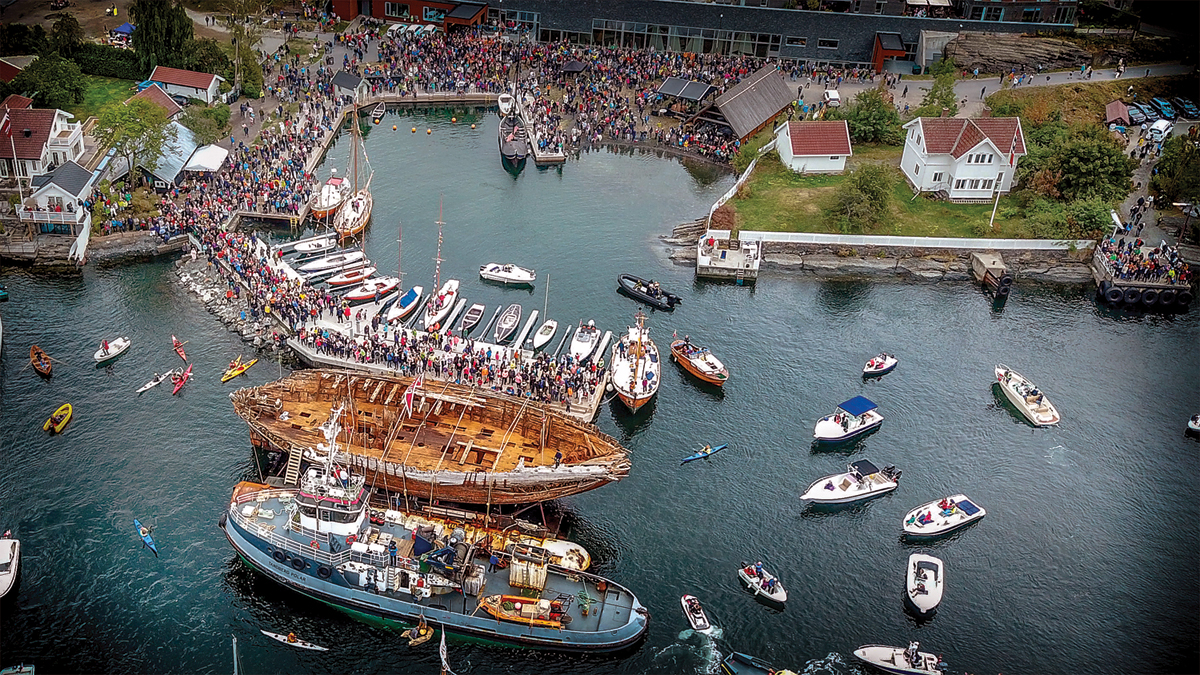
MAUD RETURNS HOME
It was nothing short of a national holiday when MAUD finally returned home to Oslo in the summer of 2018. With the completion of her century-long circumnavigation, all of Amundsen’s famous ships were united for the first time.
It took 28 days to steam from Assiaat to Vestmannaeyjar Island on the south coast of Iceland. The small harbor, oriented east–west, proved an excellent refuge from the big North Atlantic swells, and it gave the Norwegian crew some much-needed rest before their final leg home.
The weather so far had not been dangerous, but it had slowed progress. The game plan for the rest of the voyage after leaving Iceland was to head east across the top of Scotland to the west coast of Norway, arriving at the Hellisøy Light just south of Sognefjord.
Towing a barge across the North Atlantic is not an everyday practice, but it is not impossible. When weather pipes up, a tow vessel lets out cable to create a catenary, meaning that the cable forms a deep curve between the tow and towing vessel. The weight of the line acts as a kind of spring, repressing shock loads from the surge of large waves.
It worked well enough until MAUD was approaching the Faroe Islands, midway between Iceland and Scotland. Then the weather forced the convoy to duck into Klaksvik to wait out the wind.
Five days after setting off from Klaksvik, Wanggaard spotted the Hellisøy Light as dusk began to settle on the ships. MAUD had arrived in home waters. Not only had she arrived, but she at last completed the circumnavigation Amundsen set her to accomplish a century before. 
Bruce Kemp (see www.brucekempphotography.net) lives in Merrickville, Ontario, on the historic Rideau Canal. He is a regular contributor to WoodenBoat and is the author of several books, most recently Weather Bomb 1913: Life and Death on the Great Lakes.
GJØA and FRAM resurrection and restoration
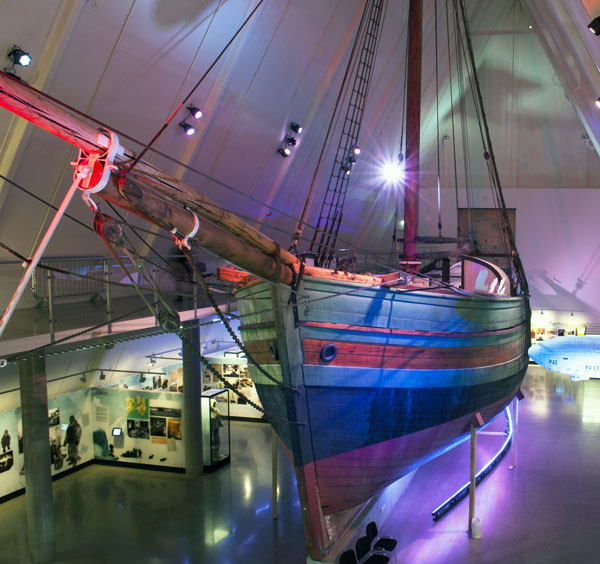
THE FRAM MUSEUM
After a major renovation in 2017, GJØA was once again opened to the public at the FRAM Museum near Oslo, where Arctic exploration ships and Roald Amundsen are held in fascination.
The Norwegian expatriates of California may have had the best of intentions when, in 1909, they set up the hull of Roald Amundsen’s GJØA in Golden Gate State Park, but the honor almost cost the world this remarkable ship.
For 63 years, GJØA slowly disintegrated. Efforts to save and restore her began in the 1930s, but the Japanese attack on Pearl Harbor in December 1941 put a quick stop to that. After the war’s end, the restoration effort rekindled in 1947; however, the efforts were not true to the vessel’s original configuration. With some relief, the ship was given to the Norwegian Maritime Museum in 1972.
Upon GJØA’s return to Norway, the Djupevåg Shipyard in Hardanger immediately set to work to restore her down to the waterline, after which the former herring sloop was exhibited outside, in the weather. That all came to a stop when the FRAM Museum took over the ship in 2009, built her a new house that opened to the public in 2013, and proceeded with some serious work on her.
The most recent restoration—which returned GJØA to her 1903 configuration—was undertaken by Hardanger Fartøyvernsenter (see WB No. 183). Before working inside the hull to replace some of the heavy structure, the crew of shipwrights began by renewing three layers of ice sheathing to a total thickness of 3″. The pine stock used for the replacement sheathing planks, roughly 8″ wide at their broadest, came from trees grown in the mountains high above sea level and was relatively knot-free.
At the same time, the crew took on the monumental job of installing a new beam shelf. The 30′-long timber, made up in two layers, was shaped outside the hull then slid into position through the existing cargo hatch. The goal was to make it look as though the timbers were accurate to the ship’s period, but common sense had to win out when fitting the timbers belowdecks with minimal disruption of the existing structure. GJØA also had new ceiling planking installed, before which her existing frames had to be faired by hand.
Most of the work on GJØA was informed by period photos. For example, in looking at a picture of Amundsen posing on deck, the crew noticed that the companionway leading to the crew’s quarters was different from the existing structure. This led to a subsequent project to rebuild it as it was in Amundsen’s day.
Also, the ice-beam replacements fitted in the 1970s were too small, so after the ceiling planking was completed the crew set about installing heavier beams. Along with the ice beams, new lodging knees were cut and installed with ¾″ bolts. Iron hanging knees between the deckbeams and the ice beams were forged, and new engine bedlogs for the 13-hp Dan gasoline engine were installed.
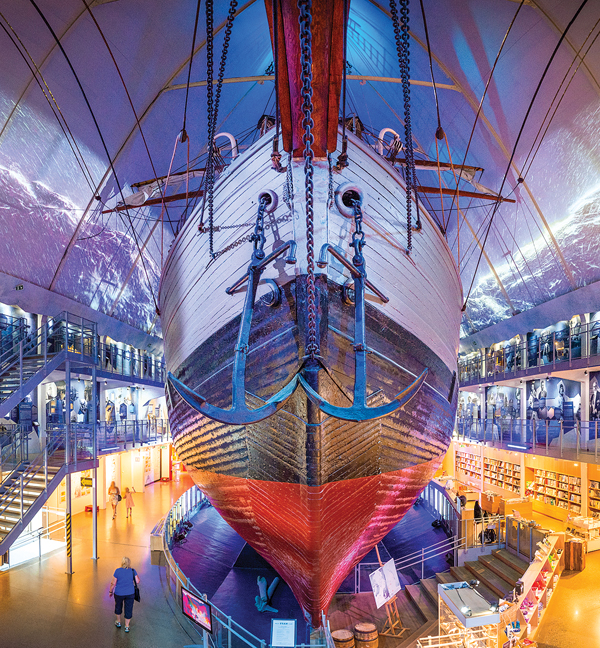
THE FRAM MUSEUM
FRAM was designed by Colin Archer for Fridtjof Nansen’s attempt to reach the North Pole, but she achieved the height of her fame with Amundsen’s successful attempt to become the first to the South Pole.
GJØA’s original capstan had been removed at some time and replaced with a smaller one. However, the Norwegian Maritime Museum had the original one in storage and returned it to GJØA for the restoration. The drums on the winch were in rough shape, so new ones were made and installed. The Hardanger crew also built a replica of the original small deckhouse that housed the galley.
On September 15, 2017, GJØA reopened for exhibition in her new building at the FRAM Museum.
By contrast, the work of rescuing FRAM started more than a century ago. Her second captain, Otto Sverdrup, was not going to let her die. By the time the ship returned to Norway from Amundsen’s Antarctic expedition in 1914, her bottom had been attacked by shipworms and she was generally in rough condition. Amundsen picked her over for parts to equip his new ship, MAUD, after which FRAM was left to molder at Horten for the duration of World War I.
When hostilities ended, Sverdrup began his efforts to rescue the ship. By 1925, a FRAM Committee had been formed, with Sverdrup at its head. Funding was not readily available in a world rebuilding from a cataclysmic confrontation. Four more years passed before her restoration began at the Famnæs Shipyard in Sandfjord, in 1929.
In agreement with Lars Christensen, his financial backer on the project, Sverdrup set about returning the ship to the way she was when she was at her best. In Sverdrup’s view, that was at the time of her second Arctic voyage of 1898–1902. After Fridtjof Nansen’s 1893–96 Arctic expedition, FRAM underwent a major refit and redesign. The deck was raised 1.9 meters (6′ 2″), opening up the accommodations belowdeck to include six additional cabins, a new galley, a workshop, and a laboratory. New ceiling was added belowdeck, bringing the hull’s thickness to 30 cm (about 12″), lined with cork for insulation.
Below the waterline, designer Colin Archer, in consultation with Sverdrup and Nansen, added a false keel that was intended to be sacrificial in the event of a hard grounding.
When the restoration work was completed, FRAM was towed to Oslo’s Bygdøy Peninsula, where she arrived May 6, 1935. She was delicately hauled out—at a rate of 1 cm (about ½″) per minute—to her waiting berth in the newly constructed FRAM House Museum, a 1,500-square-meter (16,145-sq-ft) A-frame building that accommodates both hull and standing rig.
Since opening on May 20, 1936, the museum has been a popular tourist attraction. Today, the view from the deck includes a 270-degree surround-screen audiovisual presentation of life aboard the ship as she sails through an Arctic gale, while belowdeck audiovisual shows and tours describe life in the main saloon and accommodations.
A similar exhibit building is planned for MAUD, which is currently housed under a temporary metal roof while plans are considered for a more permanent installation. —BK
A continued North American legacy
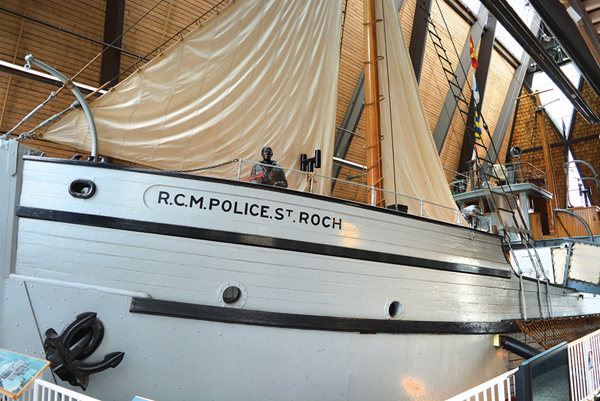
VANCOUVER MARITIME MUSEUM
MAUD’s shape and construction methods informed and inspired the designer Tom Halliday, who built the Royal Canadian Mounted Police schooner ST. ROCH in 1928. The ship is preserved in a building of her own at the Vancouver Maritime Museum in British Columbia. Though not initially intended as an Arctic explorer, she made the first west-to-east transit of the Northwest Passage and was the first ship to circumnavigate North America.
After the Hudson’s Bay Company (HBC) bought MAUD in 1925, the company had her towed to Vancouver, British Columbia, where Burrard Shipbuilding overhauled her engine and repaired her damaged keel, skeg, and rudderstock under the direction of designer Tom Halliday.
Halliday was so impressed with her concept and construction that he made careful notes, which heavily influenced his design for ST. ROCH, an auxiliary schooner built for Royal Canadian Mounted Police (RCMP) patrols in the Arctic. ST. ROCH was the last large wooden Arctic vessel built in Canada. When Halliday reviewed preliminary plans drawn up in Ottawa, he began making suggestions based on his study of MAUD. Primarily, he advocated rounding off the hull shape so that ice pressure would raise the ship rather than crush it. The planned anti-rolling bilge chocks would just be ripped off anyway, so he omitted them. To improve strength, he increased the molded depth of the frames and called for iron lodging and hanging knees for structural support instead of the proposed fir, which he felt would be too susceptible to the quick onset of rot. When he discovered that white oak could not be found in sufficiently long pieces without using heartwood, he suggested gum wood instead, which was more readily available than white oak on the West Coast.
Halliday also suggested that the thickness of the hull planking be increased for strength and to provide a solid fastening base for sheer-to-keel ironbark sheathing. Also, to add strength, he recommended a ¼″ increase in the deck planking’s thickness.
ST. ROCH was built in 1928 as a gaff-rigged schooner, but before her transit through the Northwest Passage in 1942, Capt. Henry Larsen had her reconfigured as a ketch. He wanted to step the new mizzen farther aft to allow for a larger pilothouse and so that ST. ROCH could carry “...a small riding or storm sail.” The change wasn’t a great loss, since “...the ship never sailed anyway,” as nautical archaeologist James Delgado put it. Delgado went to Cambridge Bay in 1996 to research ST. ROCH, but he also saw MAUD there for the first time and became intrigued with her historical significance.
ST. ROCH shares Arctic distinctions with the Amundsen vessels, since she was the first ship to traverse the Northwest Passage west-to-east and only the second, after GJØA, to complete the transit. She was also the first to circumnavigate North America. Like Amundsen’s vessels, she is preserved ashore, in a building of her own, as the premier artifact of the Vancouver Maritime Museum. —BK
